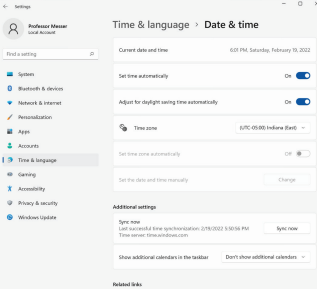3.1 - CompTIA A+ Core 2
Blue screen of death (BSOD)
Causes of startup/shutdown BSODs: Bad hardware, bad drivers, or bad applications.
Fixes for startup/shutdown BSODs: Use a Last Known Good Configuration, Windows System Restore. You can also use Windows Safe Mode. Also, try to reseat/remove hardware if possible, and run hardware diagnostics.
Degraded performance
Fix for degraded performance (Task Manager): Check for high CPU utilization and I/O (Processes tab).
Fix for degraded performance (Windows Update): Install the latest patches and drivers.
Fix for degraded performance (Disk space): check the disk for available space and defrag (use Disk Defragmentation/
dfrgui.exe).Fix for degraded performance (Power-saving mode): Check if this feature is enabled - saving power can lead to CPU throttling.
Fix for degraded performance (malware): Use an AV/anti-malware tool to scan for potential threats and remove any detected malware.
Boot issues
Common boot error types: “Operating system missing/not found”, “Boot loader replaced or damaged.”
Fixes for boot errors: Check BIOS settings to ensure the correct boot order is selected, check boot drives to remove unnecessary installation media, use Windows Startup Repair, or modify the Windows Boot Configuration Database.
Windows Boot Configuration Database (BCD): Database that stores boot configuration settings. Accessible via Windows Recovery Console, or BCEdit in Windows Registry editor.
Frequent shutdowns
Causes for frequent shutdowns: Overheating/high CPU usage - this can be due to faulty hardware components like a failing power supply, improper ventilation, application instability, or malware infections.
Services not starting
Common service not starting errors: Device not starting, “One or more services failed to start.”
Fixes for service not starting errors: Check Device Manager/Event Viewer for drivers that may need to be replaced. (
sfcin the Command line), or application service (reinstall the application).
Applications crashing
Fixes for application crashing: Check Windows Event Viewer (
eventvwr.msc), and/or Windows Reliability Monitor (Control Panel → Security and Maintenance). Also, try reinstalling the application or contacting the app’s support.
Low memory warnings
Low memory warnings: Errors that indicate your computer is low on memory (RAM).
Fixes for low memory warnings: Close unnecessary applications to free up RAM (Task Manager → Processes), increase the size of the page file (virtual memory), or consider upgrading your RAM if hardware limitations persist.
USB controller resource warnings
USB controller resource warnings: Errors that occur when USB devices are unable to communicate effectively due to insufficient system resources (i.e., insufficient number of available USB endpoints).
USB controller warning (fix): Move the device to a different USB interface, or match the USB interface to the USB device (USB 2.x interface to USB 2.x device/drive).
System instability
Fixes for system instability: Run a full Windows diagnostic, a hardware check (e.g., storage/memory), run System File Checker (
sfc), and an AV/anti-malware scan.
No OS found
Fix for “No OS found” error: Check BIOS settings/boot order to ensure the correct operating system is used for booting, also check for proper cable connections (Molex/SATA).
Slow profile load
Fix for slow profile load: Disable unnecessary startup programs and services, and clear temporary files, also fix connection to a remote DC instead of a local DC, and fix latency issues with the domain controller.
Time drift

Fix for time drift: Enable automatic time setting in Windows settings: Settings → Time & language → Date & time